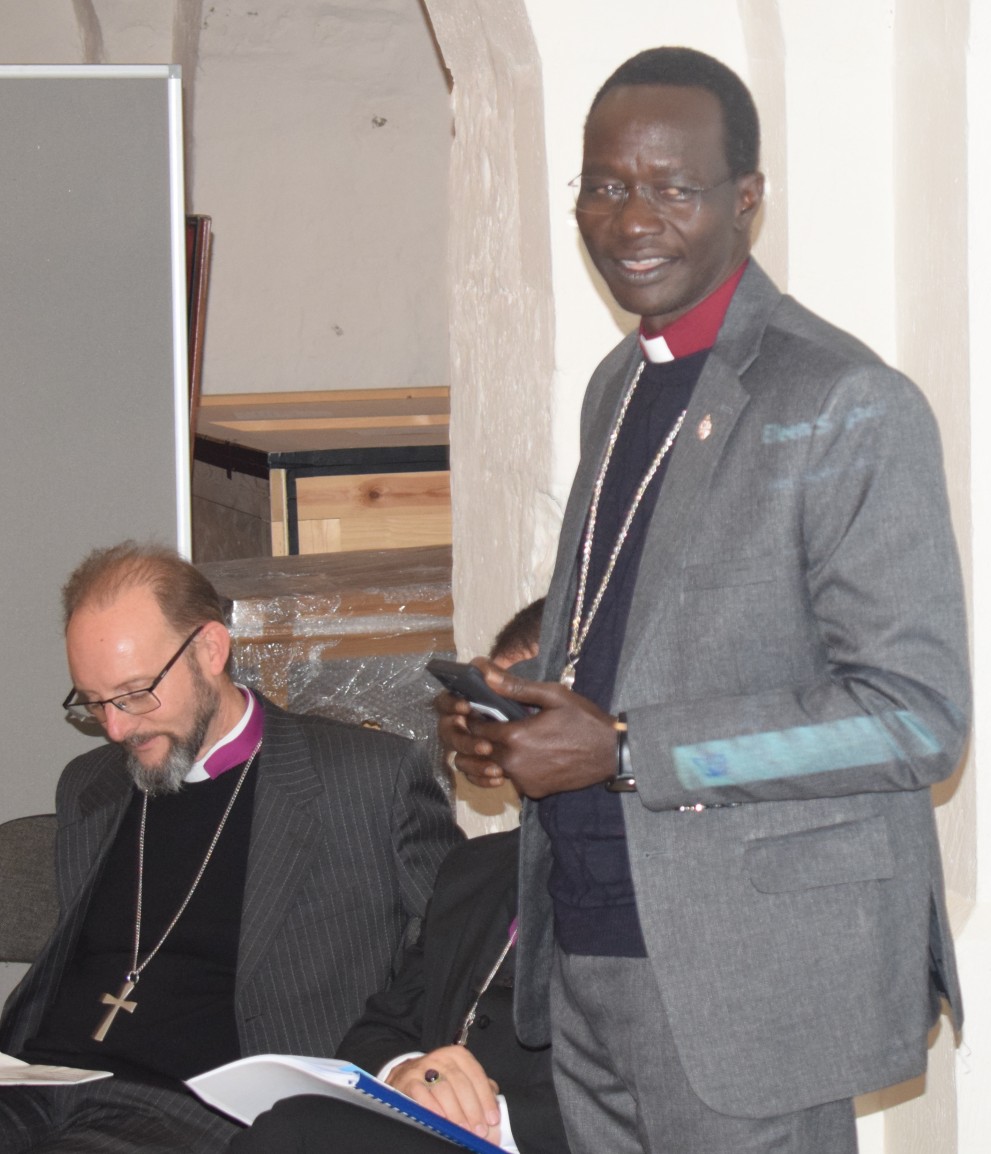Westminster Abbey was the venue for a unique meeting between the six serving bishops from the JMECA constituency and the Trustees and Directors of the organization. An afternoon session with invited guests gave an opportunity for each bishop to speak about their diocese, and for a lively discussion about the issues that will both inform JMECA’s role in the near future, and which will surely inspire all those present.
Archbishop Hosam described a church that aspired to be “more than victorious” – the theme of the Diocese of Jerusalem’s annual Majma (Synod). He spoke proudly of the heroic work of Al Ahli Hospital in Gaza which had continued to work among the injured and sick for all but five days throughout the conflict to date. JMECA is the body through which UK donations are channeled. He painted a picture of a diocese continuing to work in adverse circumstances. His personal diary had seen him promoting youth ministry, developing ecumenical relationships, supporting those graduating from church schools and encouraging vocations. There are three ordinands in training at present. The issue of violence and crime was one current priority. Raising funds to support clergy pensions was another.
Bishop Sean of Cyprus and the Gulf described his diocese as one that had a great gift to offer the communion in terms of all the ways it could be said to be at a crossroads. As a relatively new bishop he had spent time listening and building relationships. There was a financial crisis in the diocese that had necessitated a loan from the Diocesan Foundation, but he felt that the problems that had led to the crisis were ‘starting to steady.’ Work was being done on constitutional reform, and there was discussion within the diocese about a possible redrawing of its boundaries. His vision for the future was of a post-colonial diocese with a distinct middle eastern identity.

Archbishop Samy spoke both of the Province and of his own diocese of Egypt. The former would be holding epicopal elections in the three new dioceses in January. He paid tribute to Bishop Anthony for the work he had done in establishing structures for the new dioceses and wished him well for his new role as Director of the Anglican Centre in Rome. The diocese of Egypt continues with the working out of its diocesan theme of ‘a living Church for a better society.’ He gave many examples of the work of the various sectors, including the two hospitals and the various schools – with special reference to those that dealt with deaf or blind children or those who had special needs. The media sector was continuing its groundbreaking work translating the New Testament into Arabic sign language, which he hoped would be complete within four years. Work was continuing with Sudanese refugees, and three new congregations had been formed. The Interfaith department, established by Bishop Mouneer continued to do innovative work.
Bishop Martin of Ethiopia and the Horn of Africa described a diocese that had twelve churches with nine languages. They had five Sudanese priests working with the large refugee population. His priority was ‘to get the Gospel out,’ and ‘to discover the God-givens;’ that is to work with what the context provided. In this case that meant taking to heart what the New Testament had to say about aliens and strangers. Although all the work is currently located within Ethiopia, he was able to give an update on possibilities in some neighbouring countries.

Bishop Jeremiah was able to report that inter-tribal strife had given way to peace, and that the two main tribal communities had come together. The Church had played a role in that. At Synod ‘all the tribes came together and celebrated peace and love.’ He described a growing church. There were 75 churches with regular congregations of over a hundred adults, in addition to other smaller ‘mission stations’ and church plants. In this situation there was a great need for teachers who were informed disciples.
Bishop Anthony described a similar situation in Chad which was the area of the Diocese of North Africa where the churches were largely comprised of the indigenous population. He said that Anglicanism had many elements which appealed: people wanted to know more about it and churches were being planted at a rate despite there only being one church building that the diocese owned. He highlighted the attractiveness of Anglican liturgy and prayer which he said, ‘really speaks into that context.’ The bishop’s account was of growth in every direction as he outlined a mission strategy with a strong social conscience, directed to suburban areas without churches at present. Elsewhere, a first female lay minister had been licensed in Tunis, and prayers were asked for a former church secretary in prison in Libya, accused of infringement of local religious laws
Archbishop Samy said that Anglicans have something in their DNA that enables them to relate with other historic Churches, and Archbishop Hosam described the Church as the trusted glue that held the community of faith together. Bishop Sean noted that Anglicans currently held the Chair of the Gulf Council of Churches.
Bishop Jo Bailey-Wells, Deputy Secretary General at the Anglican Communion Office, chaired a lively discussion that began to identify common expectations, before Evensong in the Abbey itself – a service the Chadians would have appreciated.
You can support the work of JMECA here:
